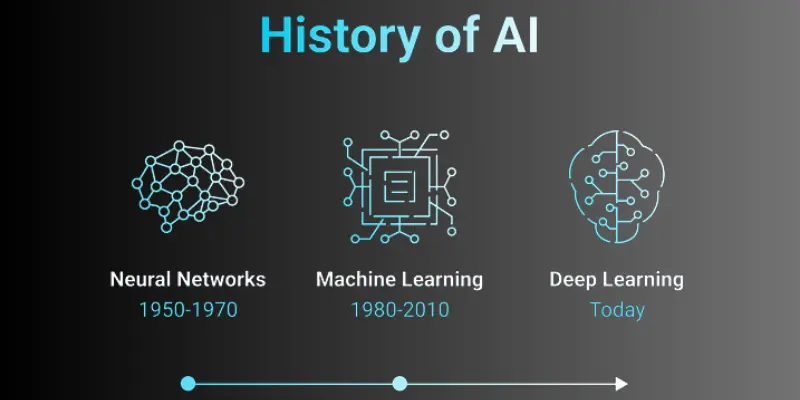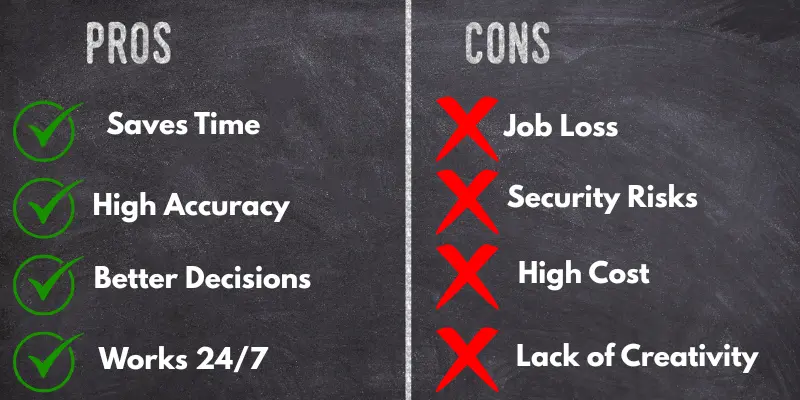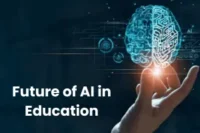What is Artificial Intelligence (AI)? A Simple Guide for Everyone
Published: 10 Oct 2025
Artificial intelligence, or AI, is a technology that enables machines to think, learn, and make decisions like humans. AI is used in everything these days, from internet shopping and smartphone apps to space travel and medical treatment. It enables us to develop more intelligent systems that are quick, precise, and effective.
This article will cover what artificial intelligence is, its types, history, applications, advantages, challenges, and prospects of artificial intelligence. Beginners can understand this instruction, but experts will find it useful because it is comprehensive enough.
What is Artificial Intelligence [AI]?
The science of building computers and computer programs that have human-like thought, learning, and decision-making abilities is known as artificial intelligence (AI). Without continual human supervision, it enables computers to comprehend language, identify images, solve issues, and get better with practice. AI is essentially the process of giving a computer a brain so it can function intelligently.
AI is demonstrated by Siri responding to voice instructions, Netflix suggesting shows you might like, and self-driving cars identifying impediments and determining when to stop or go. One of the most potent technologies of our day, artificial intelligence (AI) uses vast volumes of data and specialized algorithms to identify patterns and reach precise conclusions.

History of Artificial Intelligence [AI]
Artificial intelligence originated with the assumption that machines could be programmed to think like humans. In the 1950s, British mathematician Alan Turing proposed the “Turing Test” to assess a machine’s potential to exhibit human-like intelligence. This marked the beginning of AI as a field of research. The phrase “Artificial Intelligence” was first formally used in 1956 at the Dartmouth Conference, where researchers addressed the development of robots capable of learning and reasoning.
In the early years, the emphasis was on playing games like chess and solving easy problems. AI grew in the 1980s thanks to “expert systems,” which made judgments based on stored information. But for many years, advancement was hindered by a lack of computational capacity. AI development was revitalized in the 2000s thanks to big data, advanced computers, and sophisticated algorithms. AI is already an essential component of modern life, powering voice assistants, self-driving cars, medical diagnostics, and space exploration.
Types of AI
Artificial Intelligence can be divided into different types based on how capable and intelligent it is. The three main types are:
1. Narrow AI (Weak AI)
Narrow AI is made to perform a single task exceptionally effectively. It can’t do things that aren’t part of its mission. Facial recognition software, Google Translate, and Siri are a few examples.
2. General AI (Strong AI)
General AI is capable of human-like thought, learning, and problem-solving. It can carry out any intellectual work that a human being is capable of. There is currently no real-world use for this kind of AI, which is still in the research stage.
3. Super AI (Artificial Superintelligence)
In every aspect, super AI would be superior to humans. It might solve difficult problems more quickly than humans, come up with innovative technologies, and make wiser decisions. This kind is not yet a reality; it is merely an idea for the future.
How AI Works
Artificial Intelligence works by combining data, smart algorithms, and computing power to perform tasks that normally need human intelligence. It learns from experience, improves over time, and can make decisions without step-by-step instructions. Here’s how it works in simple steps:
- Data Collection: AI gathers data from a variety of sources, including text, photos, videos, and audio.
- Data Processing – The gathered data is cleaned, organized, and made ready for analysis.
- Algorithms: AI analyzes data and finds patterns using unique rules and guidelines called algorithms.
- Machine Learning (ML): As the system gains knowledge from data, its accuracy and functionality gradually improve.
- Deep Learning: For difficult tasks like voice comprehension and picture identification, artificial neural networks that resemble the human brain are used.
- Natural Language Processing (NLP) – Helps AI understand and respond to human language in a natural way
- Computer Vision – Enables AI to “see” and interpret images or videos.
- Decision-Making – Based on what it has learned, AI makes predictions, solves problems, and automates tasks.
Where AI is Used
Artificial Intelligence is now a part of our daily life, business operations, and even space exploration. It helps make tasks faster, smarter, and more accurate. Here are some common areas where AI is used:
- Business: AI helps businesses make smarter decisions, analyzes data to forecast sales, and enables chatbots for customer support.
- Healthcare: AI assists in diagnosing diseases, reading medical scans, and suggesting treatment plans.
- Science & Space: AI is used by agencies such as NASA for space navigation, mission planning, and satellite data analysis.
- Education: AI uses smart apps to provide tutoring, evaluate assignments, and develop individualized learning programs..
- Daily Life: Voice assistants like Siri and Alexa, smart home devices, and recommendation systems on Netflix or YouTube all use AI.
- Transportation: Self-driving cars and AI-powered traffic systems improve road safety and efficiency.
- Security: AI detects fraud in banking, monitors suspicious activities, and strengthens cybersecurity.

Advantages of AI
Artificial Intelligence offers many benefits that make tasks easier, faster, and more accurate. Here are some key advantages:
1. Saves Time
AI can complete everything far more quickly than humans, cutting down on hours of labor to a matter of seconds. Both individuals and organizations may work more productively and easily fulfill deadlines thanks to this speed.
2. Works 24/7
AI systems do not need rest or breaks, allowing them to operate continuously. This makes them perfect for roles like customer support, monitoring, and manufacturing.
3. High Accuracy
AI processes vast volumes of data without being weary or distracted by following exact algorithms. This lowers human error and improves the caliber of output.
4. Better Decisions
AI analyzes trends, patterns, and past data to help make smarter choices. Businesses use this ability to improve strategies and predict future outcomes.
5. Automation of Repetitive Tasks
AI can replace repetitive and dull tasks that humans find exhausting. People may now concentrate on more intricate and creative tasks as a result.
6. Personalization
After learning about a user’s interests, AI makes recommendations for pertinent goods, programs, or services. The user experience is improved and made more interesting as a result.
7. Handles Big Data
AI can quickly process and understand huge volumes of information that humans cannot handle easily. This makes it valuable for industries like healthcare, finance, and marketing.
Disadvantages of AI
While it has many advantages, artificial intelligence has several disadvantages that include employment, expenses, security, and innovation. To use AI ethically and minimize hazards, it’s critical to be aware of these drawbacks:
1. Job Loss
Certain industries may experience unemployment as a result of AI replacing human labor in regular or repetitive tasks. Affected communities face social and economic difficulties as a result.
2. High Cost
Developing and maintaining AI systems requires advanced technology and skilled experts, which can be expensive. Small businesses often struggle to afford these costs.
3. Lack of Creativity
AI cannot think creatively like humans since it only uses the data and rules that are provided to it. This restricts its capacity to generate genuinely novel or inventive concepts.
4. Bias in Decisions
If AI is trained on biased or incomplete data, it can produce unfair or incorrect results. This can harm individuals or groups affected by its decisions.
5. Security Risks
AI systems are at risk of hacking and malicious misuse. This brings up issues with technological abuse, safety, and privacy.
6. Dependency on Technology
Over-reliance on AI can impair people’s ability to solve problems independently. This can eventually weaken human abilities and critical thinking.
7. No Human Judgment
AI lacks emotions, empathy, and moral understanding. This makes it unsuitable for decisions that require compassion or ethical reasoning.
Future of AI
Artificial intelligence appears to have a bright future as technology advances in strength, speed, and intelligence. AI will become more prevalent in sectors including healthcare, education, transportation, and space exploration in the years to come. More sophisticated self-driving automobiles, AI-powered medical diagnoses, and robots that can work alongside people on challenging tasks are all possible.
- Artificial General Intelligence (AGI), or AI that can think and learn like a person in every circumstance, may be another significant advancement. Although technology presents amazing opportunities, it also brings up moral questions around safety, control, and the effect on employment. Strong laws and ethical application are crucial as AI develops to guarantee that society gains from technology while lowering its risks.
How to Learn AI
Although learning artificial intelligence may initially seem difficult, it may be made simpler and more enjoyable with the correct methods. Learn the fundamentals first: what artificial intelligence is, how it operates, and its applications. Learn important ideas such as neural networks, deep learning, and machine learning.
Here’s a simple roadmap to begin your AI learning journey:
- Start with Basic Math & Logic: Since these subjects form the basis of artificial intelligence, learn about probability, statistics, and linear algebra.
- Learn a Programming Language: Python is the most widely used option due to its many AI libraries and ease of use for beginners.
- Learn about Machine Learning: Examine how techniques such as decision trees, regression, and clustering are used by machines to learn from data.
- Investigate Deep Learning: Discover more about natural language processing, neural networks, and picture identification.
- Practice with Projects: Create little AI projects, including recommendation systems, chatbots, and image classifiers.
- Utilize Online Resources: Coursera, edX, YouTube, and other platforms provide beginner-to-advanced AI courses.
- Join AI Communities – Connect with other learners and professionals to share ideas and get guidance.
By following these steps and practicing regularly, you can develop real AI skills and prepare for a career in this exciting field.
Conclusion
We hope you enjoyed reading our article on Artificial Intelligence and found it helpful in understanding this exciting technology. AI is changing our world in amazing ways, and there’s so much more to explore. If you have any questions, feel free to drop them in the comments below. We’d love to hear from you! To learn more about AI and stay updated with the latest information, stay connected with us for future articles and insights.
Frequently Asked Questions (FAQs)
Here are some common questions and answers to help you understand Artificial Intelligence better.
AI, or Artificial Intelligence, means creating computer systems that can think, learn, and make decisions like humans. It helps machines do tasks such as recognizing speech, solving problems, or understanding images without being told exactly what to do step-by-step.
The four types of AI are:
- Reactive Machines
- Limited Memory
- Theory of Mind
- Self-Aware AI
AI is used in virtual assistants, recommendation systems, self-driving cars, medical diagnosis, and even in chatbots like me.
AI can be harmful if misused, such as spreading misinformation or replacing human jobs. But with proper regulation, it can be very beneficial.
Learning programming languages like Python, researching AI ideas online, and working with AI tools and projects are good places to start.

- Be Respectful
- Stay Relevant
- Stay Positive
- True Feedback
- Encourage Discussion
- Avoid Spamming
- No Fake News
- Don't Copy-Paste
- No Personal Attacks

- Be Respectful
- Stay Relevant
- Stay Positive
- True Feedback
- Encourage Discussion
- Avoid Spamming
- No Fake News
- Don't Copy-Paste
- No Personal Attacks





